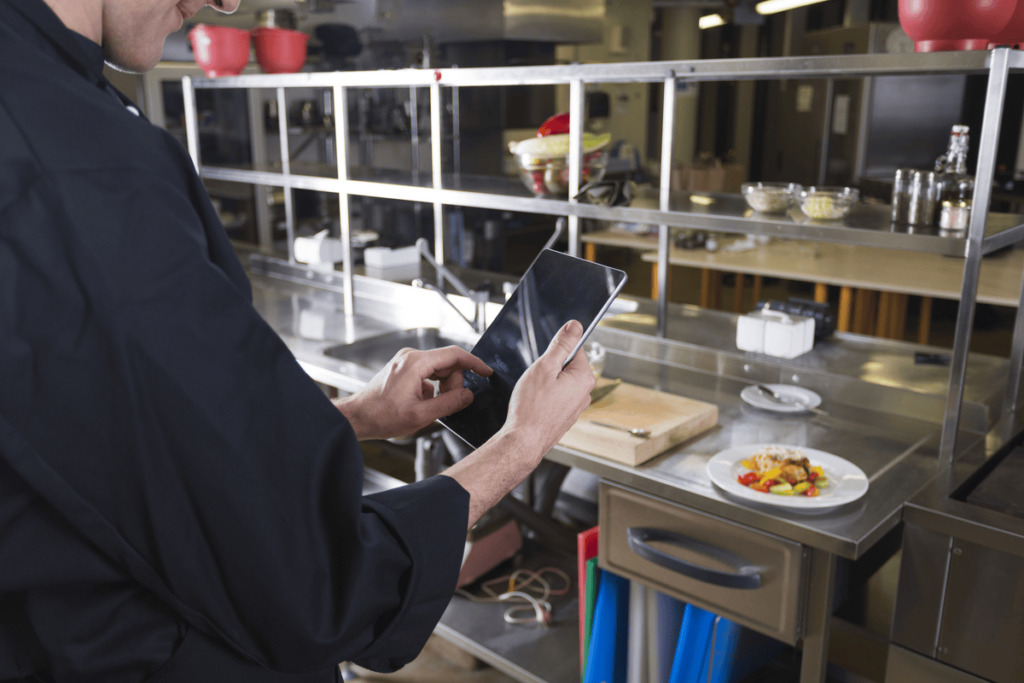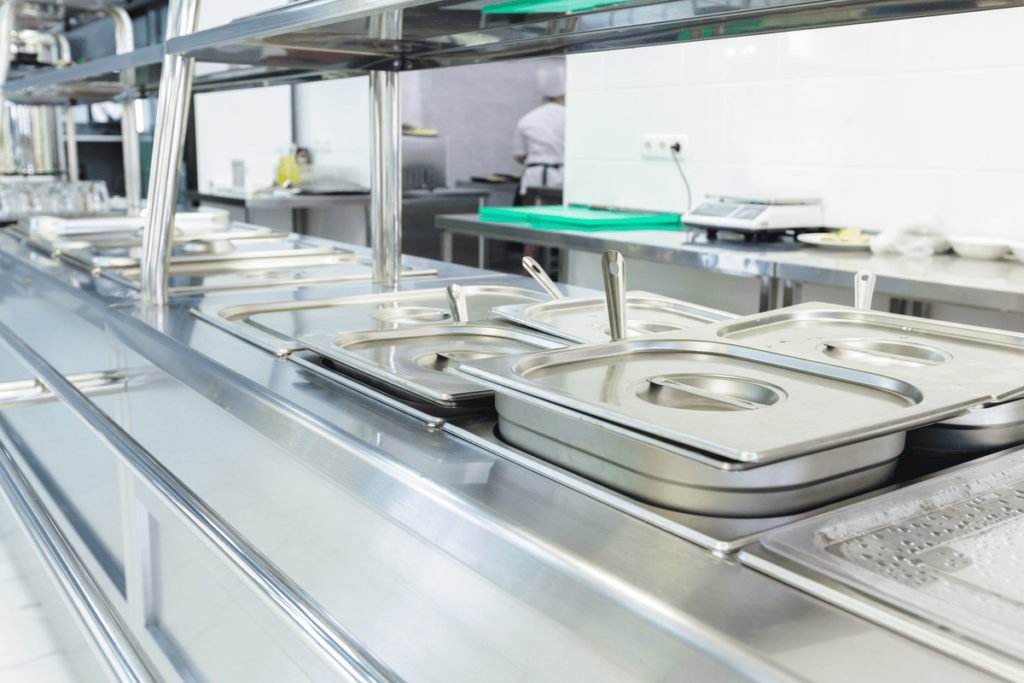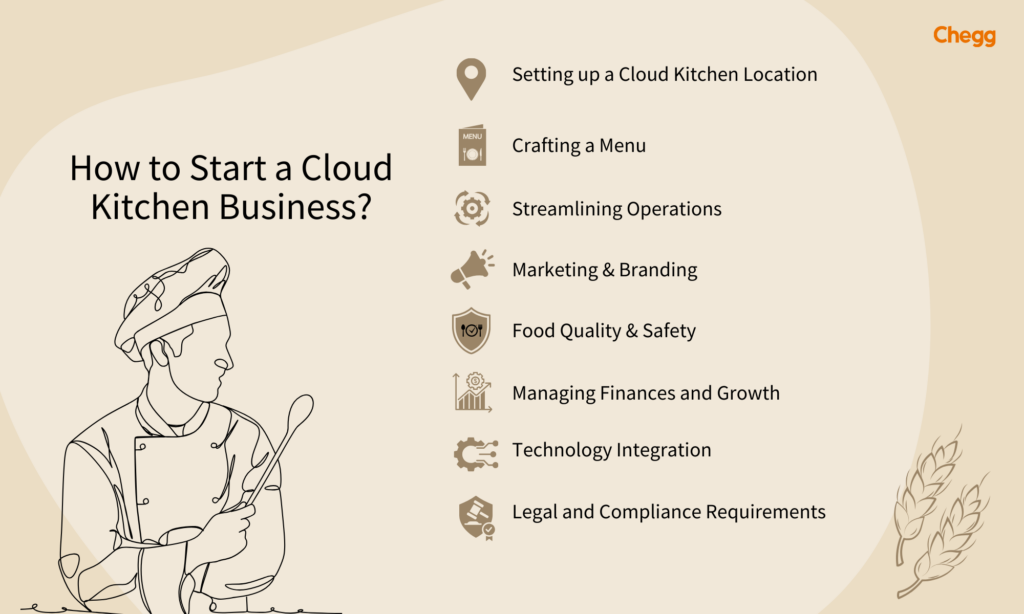

Quick Summary
Are you thinking about starting a cloud kitchen business in India? You’re not alone! Many entrepreneurs are turning to this innovative model because it’s cost-effective, scalable, and perfect for the growing food delivery market. In this guide, we’ll walk you through everything you need to know about running a successful cloud kitchen business in India. From understanding a cloud kitchen to learning how to start one, this article will provide detailed, actionable insights to help you succeed.

A cloud kitchen business is a restaurant that operates only for online food delivery. Unlike traditional restaurants, these kitchens don’t have dining areas or seating arrangements. Instead, they focus entirely on preparing food for delivery platforms like Swiggy, Zomato, and Uber Eats.

India’s cloud kitchen business model is booming due to the increasing demand for home-delivered meals. According to recent reports, the Indian food delivery market is expected to grow at a CAGR of 12% over the next few years. This makes exploring this good food cloud kitchen and restaurant business opportunity an excellent time.

To understand how a cloud kitchen business operates, let’s break it down step by step:
By following these steps, you can set up a smooth-running cloud kitchen business that meets the needs of modern consumers.
Various cloud kitchen business models cater to different types of entrepreneurs, from independent cloud kitchen startups to large-scale franchises. Let’s explore the different models in detail.
An independent cloud kitchen is a simple business model in which a single restaurant brand prepares and delivers food without any physical dining space. This type of cloud kitchen operates from a rented or owned kitchen and accepts orders through food delivery apps like Swiggy, Zomato, or Uber Eats.
This model is perfect for individuals who want to enter the cloud kitchen business with limited investment and focus solely on food preparation.
A multi-brand cloud kitchen is a single kitchen that operates multiple food brands under one company. Each brand serves a different cuisine, allowing the business to target various customer preferences using the same kitchen infrastructure.
This model is widely used in the cloud kitchen business to optimize operations and increase profitability by catering to diverse food choices.
An aggregator-managed cloud kitchen is a business model where food delivery platforms like Swiggy, Zomato, or Uber Eats provide kitchen spaces to restaurant brands. The restaurants focus solely on food preparation while the aggregator manages logistics, online orders, and customer service.
This cloud kitchen business model benefits both the aggregator and restaurants, enabling efficient order fulfillment without high operational costs.
A franchise-based cloud kitchen is a model where an investor or entrepreneur purchases the right to operate a well-known cloud kitchen business under a popular brand name. The franchisee follows the brand’s menu, recipes, and operational guidelines while paying royalties or fees to the parent company.
This model is ideal for those who want to enter the cloud kitchen business with a trusted and profitable brand, reducing the risk of failure.
A co-working cloud kitchen allows multiple food brands or restaurant operators to share the same kitchen space. This reduces operational costs, improves efficiency, and allows small businesses to access high-quality kitchen infrastructure.
This model benefits new entrepreneurs entering the cloud kitchen business with limited capital but aiming for maximum efficiency.
The cloud kitchen business has transformed the food industry by offering cost-effective and scalable solutions for restaurant operations. Whether you want to start a small independent cloud kitchen restaurant or invest in a multi-brand or franchise-based model, there are various opportunities in this growing market.
Starting a cloud kitchen business involves careful planning and execution. Here’s a step-by-step guide on Cloud Kitchen and how to start such a business:

Finding a suitable location is the first step in setting up & how to open a cloud kitchen. Unlike conventional eateries, cloud kitchens don’t require excellent real space with plenty of foot activity. Instead, concentrate on locations with many potential clients and simple access to delivery partners. Renting a commercial kitchen space in a commercial or residential neighborhood might be more economical.
Creating a successful cloud kitchen menu is crucial. Focus on specialty cuisine or standout dishes to streamline operations and elevate service quality. Choose foods that travel well and maintain their taste and texture, avoiding dishes prone to quality degradation. Price your menu competitively, considering ingredient costs, packaging, and market trends for optimal value perception.
Efficiency is essential for cloud kitchens to guarantee on-time deliveries and excellent cuisine. Operations optimization includes optimizing several processes, such as:
Effective branding and marketing are crucial to attracting cutthroat online meal delivery market clients. The following are some methods for marketing your cloud kitchen company:
Implement a customer loyalty program to encourage repeat business and thank devoted customers.
Food safety and consistent food quality are essential for every food business. Customers cannot experience the ambiance in a cloud kitchen model; thus, you must rely on your food and service quality. Think about the following:
Effective financial management is crucial for the success and growth of your cloud kitchen business. Focus on these key considerations:
Incorporating technology into your cloud kitchen business can significantly enhance efficiency and customer experience. Consider these aspects:
Ensuring your cloud kitchen meets all legal and regulatory requirements is crucial for smooth operations. Focus on the following:
Launching a successful cloud kitchen business requires careful planning. First, select a strategic location that supports efficient delivery and operations. Next, develop a focused menu that highlights your unique offerings. Optimize your cloud kitchen business operations to ensure efficiency and timely service. Invest in marketing to build your brand and attract customers. Prioritize food quality and safety to ensure customer satisfaction and compliance. Manage finances wisely to keep your cloud kitchen business profitable. Stay adaptable to changes in the market and responsive to customer feedback.
This approach will help your cloud kitchen business remain competitive and grow in the evolving food delivery industry.


If you’re still unsure whether a cloud kitchen business is right for you, here are some compelling advantages:
Traditional restaurants require significant capital for renting large spaces, interior design, and hiring waitstaff. A cloud kitchen business, on the other hand, requires much less investment. You can start with as little as ₹2-5 lakhs.
Your monthly expenses will be much lower without needing front-of-house staff, utilities like air conditioning, or expensive decor. This allows you to reinvest profits into growing your business.
Since delivery apps charge commissions (usually 20-30%), having a lean operation helps maximize your earnings. Plus, you can serve more customers without worrying about seating capacity.
With a cloud kitchen business, you can test new cuisines or concepts without risking too much. For example, if biryani isn’t selling well, you can quickly pivot to burgers or wraps.
India’s urban population is increasingly relying on food delivery services. Whether it’s office-goers ordering lunch or families enjoying dinner at home, the demand for convenient meal options continues to rise.
While the cloud kitchen business model has many benefits, it also comes with challenges. Here’s what you should be prepared for:
Most of your sales will come from food delivery apps, so you must share some of your revenue. To mitigate this, consider building your app or website.
The food delivery market is crowded, especially in cities like Mumbai, Delhi, and Bangalore. Standing out requires creativity, consistency, and excellent marketing.
Delays in delivery or incorrect orders can harm your reputation. It’s crucial to partner with reliable delivery services and maintain open communication.
FSSAI licenses, fire safety certificates, and hygiene standards are mandatory for all food businesses in India. Make sure you meet all legal requirements before launching your cloud kitchen business.
Despite these challenges, a well-planned strategy can help you overcome obstacles and thrive in the industry.

Starting a cloud kitchen business in India is a smart move for aspiring entrepreneurs looking to capitalize on the booming food delivery market. You can build a profitable venture that satisfies hungry customers nationwide by keeping costs low, focusing on quality, and leveraging digital platforms.
Remember, success doesn’t happen overnight. Stay patient, adapt to changes, and continuously improve your offerings. With dedication and hard work, your cloud kitchen business can become a household name!
Want to earn money from the comfort of your home? Our guide will help you find Online Jobs.
Read More :-
Cloud kitchens can be highly profitable due to lower overhead costs and the increasing demand for food delivery services. Success depends on factors like location, cuisine, and effective marketing.
To start a cloud kitchen, choose a suitable location, get the necessary licenses, set up kitchen space, develop a menu, partner with food delivery platforms, and market your brand. Focus on quality and customer service to build a loyal customer base.
Yes, cloud kitchens are legal in India. You must comply with local regulations and obtain necessary licenses, such as an FSSAI, fire safety certificate, and shop and establishment license.
Cloud kitchens are primarily B2C (Business to Consumer) as they directly serve end customers through delivery platforms or their channels. However, they can also have a B2B element if they partner with food delivery services, aggregators, or other businesses for expanded reach.
A cloud kitchen, also known as a ghost kitchen or dark kitchen, is a commercial kitchen that prepares food exclusively for delivery or takeout. It operates without a physical storefront or dine-in facility and focuses on fulfilling online orders through food delivery platforms.

Authored by, Amay Mathur | Senior Editor




Amay Mathur is a business news reporter at Chegg.com. He previously worked for PCMag, Business Insider, The Messenger, and ZDNET as a reporter and copyeditor. His areas of coverage encompass tech, business, strategy, finance, and even space. He is a Columbia University graduate.
Editor's Recommendations
Chegg India does not ask for money to offer any opportunity with the company. We request you to be vigilant before sharing your personal and financial information with any third party. Beware of fraudulent activities claiming affiliation with our company and promising monetary rewards or benefits. Chegg India shall not be responsible for any losses resulting from such activities.
Chegg India does not ask for money to offer any opportunity with the company. We request you to be vigilant before sharing your personal and financial information with any third party. Beware of fraudulent activities claiming affiliation with our company and promising monetary rewards or benefits. Chegg India shall not be responsible for any losses resulting from such activities.